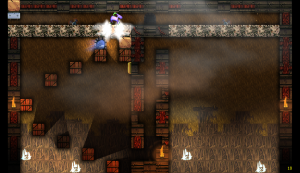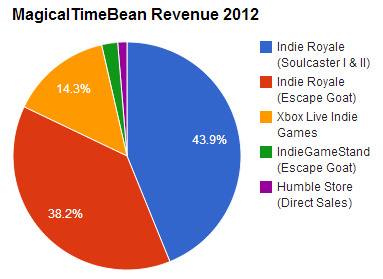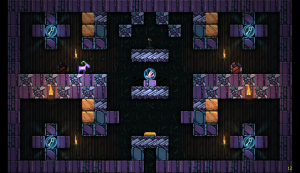Last week I spent three days at CasualConnect in San Francisco showing Escape Goat 2, as part of their amazing Indie Prize event. Free demo space, lunches, snacks, and an open bar every day! I felt like royalty. I wish I had time to play more games and see more of the show, but I was pretty committed to demoing Escape Goat 2 the whole time. I hardly left my table during show hours.
The most common question I got was “So is this coming to mobile?” which has a lot to do with it being CasualConnect. Being a paid-up-front, download game on PC, I was definitely a fringe title for the event. I resisted the urge to give a flat “no” to the mobile port question, and instead explain how the game would need to be redesigned for touch input, and with a direct port it just wouldn’t be a high quality game. (Imagine: Virtual D-Pad) Pretty much everyone got it when I put it that way. Each platform has a cost of porting, and I have a limited amount of time… it comes down to prioritization.
The priority is a basic equation: Potential revenue divided by hours of work.

It’s tricky because both of these numbers are guesses. For something like Wii-U, I doubt I could even get in the ballpark for either figure, so I’d have to do more research. For Xbox Live Indie Games, I have already released three games there, so I have a much clearer picture.
1. Potential Revenue
For potential revenue, I could look at how much each of my games made in their first year. I wish I had kept all the reports, because I can only download the most recent ones. But from the data I managed to revive, here are some estimates:
| Game |
Launch |
First year revenue |
| Soulcaster |
March 2010 |
$8,000 |
| Soulcaster II |
December 2010 |
$4,500 |
| Escape Goat |
November 2011 |
$4,000 |
A lot of people are shocked when I tell them these figures. But that’s just XBLIG, only certain types of games really make viable revenue there. And as you can see, the trend is–though my games are getting objectively better–they make a little less money each time. It’s probably that the marketplace is getting more more crowded with high quality titles.
Compare those figures to what I made when these games launched on PC, in the Indie Royale bundle:
| Game |
Launch |
Bundle Revenue |
| Soulcaster I & II |
February 2012 |
$17,000 |
| Escape Goat |
June 2012 |
$15,000 |
This graph illustrates my 2012 revenue breakdown:

There’s a chance Escape Goat 2, with its higher production value, will make more money than any of my other games on XBLIG. Very true! There’s also a chance that when the Xbox One comes out, Microsoft puts the 360 into the federal witness protection program, like they did with the Xbox when the 360 came out. Maybe the One will have a great self publishing deal–I’m keen to learn more about this in the coming months. But my future is not with the 360.
On the subject of revenue, there’s also the issue of pricing. Do I really offer my $10 PC game on XBLIG for just $1? I bet it would make more money there, but does this help me in the long run on other platforms?
2. Cost of Porting
The other variable in the equation is the time it will take to port. Now being built from the Escape Goat code base, EG2 should be ready to rock on the 360, right? Not really. The new lighting engine required a new renderer, so we’re not 100% organic XNA anymore. It could take a couple weeks to get the code to compile for 360, not to mention time spent on optimization. The file system needs to change to use storage devices. I have to remove every instance of default paramters. I’ve got to do Evil Checklist testing, go through playtest and peer review. It could easily be a month-long project, and yield a separate code base in need of maintenance.

Escape Goat 2 has been chartered to make money. If I’m going to do this indie thing full time, I have to pick my battles wisely. I have a lot of fans on Xbox who don’t have a PC, or prefer to game on console (just like me!) and it bums me out that I have to snub them this time around. I wish it wasn’t like this, and I hope in reading this article you can see what went into the decision to avoid XBLIG.
The Future
But just so this article isn’t a total bummer, let me close by saying that Escape Goat 2 really works best as a console game, and it will be on a console. Couch and controller. I will be in contact with Nintendo, Sony and Microsoft later this year to see what it’ll take to port and publish on Wii-U, PS4 and Xbox One. I hope to see you guys on one of those systems. I owe my indie career to XBLIG, and it will always be special to me.
I’ll see you on the PC in September, and we’ll take it from there as opportunities come up.


